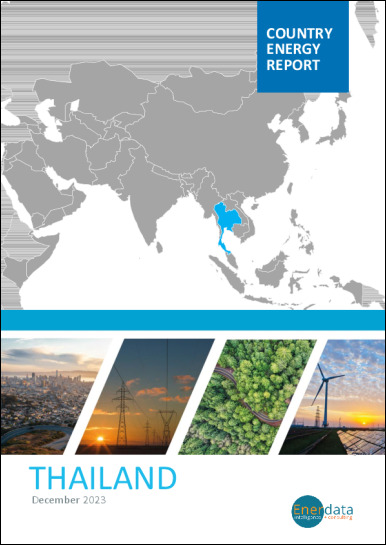- Update
-
- Format
- 4 files (PDF report, 3 Excel files)
- Pages
-
35 (Report only)
- Delivery
- Immediate by e-mail
- GENERAL OVERVIEW
- INSTITUTIONS AND ENERGY POLICY
- ENERGY COMPANIES
- ENERGY SUPPLY
- ENERGY PRICES
- ENERGY CONSUMPTION
- ISSUES AND PROSPECTS
- DATA TABLES
- ABBREVIATIONS
- GLOSSARY
Buy Thailand energy report
Price without VAT. Depending on your statute and location, VAT might be applicable. Get in touch with us for more information.
After validation, you will immediately receive 4 files by email (one pdf report and 3 excel files containing the datasets).
Overview
This analysis includes a comprehensive Thailand energy market report and updated datasets. It is derived from the most recent key economic indicators, supply and demand factors, oil and gas pricing trends and major energy issues and developments surrounding the energy industry. The report provides a complete picture of the country situation, dynamics, current issues and future prospects. With market data and continuous follow-up of markets news, this report brings clear and concise insights with which to tackle national energy challenges and opportunities. Browse the tabs below for a detailed table of contents, the list of graphs and tables, and details on the data files.
Highlights
- Thailand targets a 30% reduction in GHG emissions by 2030, from a BAU scenario, and carbon neutrality by 2050.
- The introduction of a carbon tax is planned for 2025.
- PTTEP is the main oil and gas company, with around 70% and 80%, respectively, of the country's production.
- State-owned electricity company EGAT is the largest power generator, with 45% of total capacity.
- Natural gas dominates the power mix (67% in 2023).
- Gas production dropped by 17% in 2022 as PTTEP struggles to boost production from maturing fields.
- Energy prices in Thailand are much higher than in Malaysia (over a factor of 2 for gasoline and diesel and a factor of 3 for household electricity).
- Final energy consumption has remained fairly stable since 2019.
- Oil products account for over half of this consumption.
- Industry is the largest consumer with 53% of final consumption and 37% of electricity consumption.
- The new National Energy Plan will significantly increase the share of renewables at the expense of gas and coal. Around 6 GW of solar projects are planned.
- Negotiations restarted with Cambodia for the exploration of a large oil and gas offshore field.
Institutions & Energy Policy
The Ministry of Energy is responsible for energy policy development through the Energy Policy and Planning Office (EPPO). The National Energy Policy Committee (NEPC), chaired by the Prime Minister, is the decision-making body.
Energy Companies
Oil:
Petroleum Authority of Thailand (PTT) is the national oil company (63.3% public, of which 51.1% directly held by the Ministry of Finance and 12.2% through the Vayupak Fund).
Energy Supply
Oil:
The production of liquid hydrocarbons (crude oil and NGL) has been decreasing since 2016 (-6.9%/year), reaching 11.9 Mt in 2023. Previously, it had increased rapidly between 2000 and 2016 (+6%/year).
Energy Prices
Oil:
Motor fuel prices are deregulated. Gasoline prices have increased by around 50% since 2020 to US$1.06/l in 2023, while diesel prices rose by only 30% to US$0.92/l.
Gasoline prices in Thailand are 2.3 times higher than in Malaysia, while diesel prices are 2.2 times higher (2023). Compared to Vietnam, diesel and gasoline prices are 10% higher for both fuels (2023).
Energy Consumption
Per capita energy consumption stood at 2.1 toe in 2023, while per capita electricity consumption was 2 977 kWh.
Total energy consumption has been increasing by 2%/year since 2020, reaching 149 Mtoe in 2023. Previously, it had increased by 1.8%/year as from 2010 and dropped by 6.4% in 2020.
Issues & Prospects
Pending the official release of the National Energy Plan (NEP), which is still pending as of early 2025, the Thailand Integrated Energy Blueprint (TIEB) 2015 remains in force and defines the energy trajectory until 2036. Oil demand is expected to increase by 3.3%/year until 2036 in the BAU scenario.
 Energy and Climate Databases
Energy and Climate Databases Market Analysis
Market Analysis